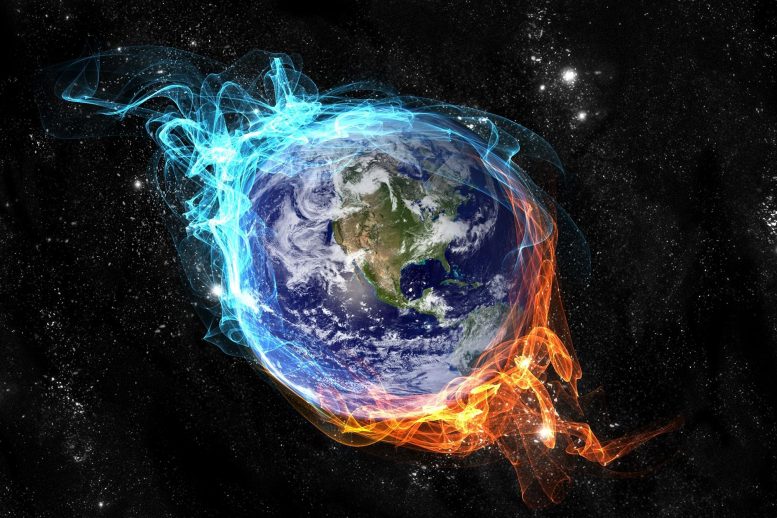
A new study emphasizes the critical risk posed by overshooting the 1.5°C global warming limit, pointing to substantial tipping risks for key climate elements like ice sheets and rainforests. Achieving net-zero emissions is deemed crucial to mitigating these risks.
Current climate policies imply a high risk for tipping of critical Earth system elements, even if temperatures return to below 1.5°C of global warming after a period of overshoot. A new study indicates that these risks can be minimized if warming is swiftly reversed.
Anthropogenic climate change poses a risk to critical components of the Earth system, including ice sheets, ocean currents, and other key biospheric elements, often referred to as tipping elements. A recent study in the scientific journal Nature Communications by researchers from the International Institute for Applied Systems Analysis (IIASA) and the Potsdam Institute for Climate Impact Research (PIK) examines the potential destabilization of four major climate tipping elements under existing mitigation strategies and projected future emissions.
The scientists determined the tipping risks for destabilizing at least one of four core climate elements as a consequence of overshooting 1.5°C: the Greenland Ice Sheet, the West Antarctic Ice Sheet, the Atlantic Meridional Overturning Circulation (the main ocean current system in the Atlantic Ocean), and the Amazon Rainforest. All four contribute to regulating the stability of the Earth’s climate system. Global warming can trigger abrupt changes in these biophysical systems, leading to irreversible consequences.
The authors’ analysis shows how crucial it is for the state of the planet to adhere to the climate objectives of the Paris Agreement and emphasizes the legacy of our climate (in)action today for centuries to millennia to come.
The Crucial Need for Net-Zero Emissions
“Our results show that to effectively limit tipping risks over the coming centuries and beyond, we must achieve and maintain net-zero greenhouse gas emissions. Following current policies this century would commit us to a high tipping risk of 45% by 2300, even if temperatures are brought back to below 1.5°C after a period of overshoot,” says co-lead author Tessa Möller, a researcher in the Integrated Climate Impacts Research Group of the IIASA Energy, Climate, and Environment Program and at PIK.
The authors found that tipping risks by 2300 are substantial for several of the assessed future emission scenarios. Failing to return to below 1.5°C by 2100, despite reaching net-zero greenhouse gas emissions, results in tipping risks of up to 24% by 2300, meaning that in around a quarter of model runs under scenarios that fail to return to below 1.5°C by 2100, at least one of the considered tipping elements has tipped.
Policy Implications and Warming Reversal
“We see an increase in tipping risk with every tenth of a degree of overshoot above 1.5°C. If we were to also surpass 2°C of global warming, tipping risks would escalate even more rapidly. This is very concerning as scenarios that follow currently implemented climate policies are estimated to result in about 2.6°C global warming by the end of this century,” says Annika Ernest Högner from PIK, who co-led the study.
“Only a swift warming reversal after overshoot can effectively limit tipping risks. This requires achieving at least net-zero greenhouse gases. Our study underscores that this global mitigation objective, enshrined in Article 4 of the Paris Agreement, is vital for planetary stability,” adds IIASA Integrated Climate Impacts Research Group Leader, Carl Schleussner, one of the study authors.
According to the researchers, the advanced models currently used to study the Earth’s systems are not yet able to fully capture the complicated behaviors, feedback loops, and interactions between some of the tipping elements. To address this, the team used a simpler, stylized Earth system model that represents these tipping elements using four connected mathematical equations. By doing so, they also took future stabilizing interactions into account, like the cooling effect of the weakening Atlantic Meridional Overturning Circulation onto the Northern Hemisphere.
Model Limitations and Legal Imperatives
“This analysis of tipping point risks adds further support to the conclusion that we are underestimating risks, and need to now recognize that the legally binding objective in the Paris Agreement of holding global warming to well below 2°C, in reality means limiting global warming to 1.5°C. Due to insufficient emission reductions, we run an ever increasing risk of a period of overshooting this temperature limit, which we need to minimize at all costs to reduce dire impacts to people across the world,” concludes PIK Director and study coauthor Johan Rockström.
For more on this study, see How Close Are We to the Climate’s Point of No Return?
Reference: “Achieving net zero greenhouse gas emissions critical to limit climate tipping risks” by Tessa Möller, Annika Ernest Högner, Carl-Friedrich Schleussner, Samuel Bien, Niklas H. Kitzmann, Robin D. Lamboll, Joeri Rogelj, Jonathan F. Donges, Johan Rockström and Nico Wunderling, 1 August 2024, Nature Communications.
DOI: 10.1038/s41467-024-49863-0









“The scientists determined the tipping risks for destabilizing at least one of four core climate elements as a consequence of overshooting 1.5°C: the Greenland Ice Sheet, the West Antarctic Ice Sheet, the Atlantic Meridional Overturning Circulation (the main ocean current system in the Atlantic Ocean), and the Amazon Rainforest.
During the Eemian, Greenland lost most of its ice for a period of time long enough for diverse vegetation to re-colonize the exposed ground and develop soils, as shown by Chester Langway of the Cold Regions Research and Engineering Laboratory. Guess the ‘irreversible’ event got reversed!
There are good reasons to believe that, unlike East Antarctica, West Antarctica is influenced by high rates of geothermal heat derived from submarine and under-ice volcanic and spreading-center activity. Net zero won’t do much for the WAIS.
The idea of the AMOC came from geological evidence that the rapid, massive melting of continental glaciers at high northern latitudes flooded the oceans with huge volumes of freshwater floating on the surface of the Atlantic Ocean. Guess what? That wasn’t irreversible either. The stalled currents started up again after the freshwater mixed with the salty ocean waters. Today we don’t have a situation even remotely resembling the 2-mile high glaciers that covered North America and most mountain ranges in the world. Thus, there is low to no probability of the AMOC being disrupted until the end of the next major glaciation, which may be forestalled if anthropogenic warming is as powerful as some believe.
We have only recently discovered that huge acreages of the Amazon Basin were cleared of the diverse tropical vegetation that we have come to think of as being the natural state.
[https://scitechdaily.com/rewriting-history-new-research-reveals-that-there-are-thousands-of-undiscovered-pre-columbian-sites-in-the-amazon-rainforest/ ] We don’t have a clue what the Amazon was like before it was cleared for agriculture by early peoples. Much like with the Mayans, the large-scale modifications didn’t prevent Nature from reclaiming the land. Another example of conjecture about irreversibility that actual evidence says didn’t happen, despite the fact that the land-use changes probably changed the Amazon climate.
The simple fact that Earth isn’t locked into an extreme, permanent climate, despite having been both much warmer and much colder over the last 4.5 billion years, argues that so-called irreversible climate ‘tipping points’ are no more real than unicorns. Both are a figment of an overactive mind that has psychological drivers not recognized by the proponents. The claimed probabilities (about the same as flipping a coin) are based on computer models of unknown veracity.